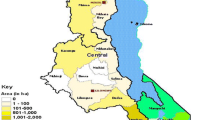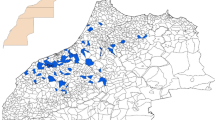Abstract
The diffusion of agricultural technologies is influenced by a number of factors, including the farm-, household- and location-specific characteristics, institutions, infrastructures, and agri-food policies. The empirical literature, however, focuses largely on the household-level factors, ignoring the higher-level factors that simultaneously may influence the technology diffusion process. Employing a multilevel modeling approach this paper analyzes the mutually reinforcing and reciprocal relationships between people (compositional effects) and places (contextual effects) to know the relative importance of different geographical or administrative levels in the diffusion of modern crop varieties in India. The findings show strong contextual effects of states (i.e., policies) and also equally strong compositional effects of the between household differences. These findings suggest the need for a greater policy emphasis on agricultural research and dissemination of its outputs, and redressal of the constraints that farmers face in switching over to new technologies and innovations. Further, the findings also suggest that relaxing credit and information constraints will accelerate the spread of technology diffusion. The contextual effects of the intermediate geographical levels are small, and point towards strengthening coordination between different geographical levels for faster dissemination of technologies and subsequent realization of their economic and social outcomes.




Similar content being viewed by others
Data availability
The data and material will be made available upon request.
Notes
Indian society is stratified along religion and caste, but caste is an important indicator of social status. There are four broad caste groups viz., scheduled castes, scheduled tribes, other backward castes and upper castes. Scheduled castes and scheduled tribes are at the bottom of caste hierarchy and are considered to be socially-disadvantaged; other backward castes lie in the middle, and the upper castes at the top.
In our dataset, we find a negative correlation between the age and farming experience of the household-heads (r = −0.18).
In our classification, loamy, sandy-loam and clay represent primarily the alluvial soils and are more fertile. The black and red soils are relatively less fertile. In particular the black soils swell on wetting and shrink on drying, and thus are difficult to manage for crop cultivation. Red soils are poor in nitrogen, phosphorous, potassium and lime. We consider black and red soils as less fertile.
Formal sources include the government extension workers, Krishi Vigyan Kendras (KVKs) i.e. Agriculture Science Centers and Agricultural Universities. The informal sources comprise of the progressive farmers, media and input dealers.
References
Ali, J. (2012). Factors affecting the adoption of information and communication technologies (ICTs) for farming decisions. Journal of Agricultural & Food Information, 13(1), 78–96.
Asfaw, S., Shiferaw, B., Simtowe, F., & Haile, M. (2011). Agricultural technology adoption, seed access constraints and commercialization in Ethiopia. Journal of Development and Agricultural Economics, 3(9), 436–477.
Barrett, C. B., Bachke, M. E., Bellemare, M. F., Michelson, H. C., Narayanan, S., & Walker, T. F. (2012). Smallholder participation in contract farming: Comparative evidence from five countries. World Development, 40(4), 715–730.
Batte, M. T., & Arnholt, M. W. (2003). Precision farming adoption and impact in Ohio: Case studies of six leading-edge adopters. Computers and Electronics in Agriculture, 38, 125–139.
Birthal, P. S., Kumar, S., Negi, D. S., & Roy, D. (2015). The impacts of information on returns from farming: Evidence from a nationally representative farm survey in India. Agricultural Economics, 46(4), 549–561.
Birthal, P. S., Hazrana, J., Negi, D. S. (2019). A multilevel analysis of drought risk in Indian agriculture: Implications for managing risk at different geographical levels. Climatic Change, 1–15.
Birthal, P. S., Hazrana, J., & Negi, D. S. (2020). Diversification in Indian agriculture towards high value crops: Multilevel determinants and policy implications. Land Use Policy, 91, 104427.
Ceccarelli, S. (2015). Efficiency of plant breeding. Crop Science, 55, 87–97.
Deichmann, U., Shilpi, F., & Vakis, R. (2009). Urban proximity, agricultural potential and rural non-farm employment: Evidence from Bangladesh. World Development, 37(3), 645–660.
Emran, M. S., & Hou, Z. (2013). Access to markets and rural poverty: Evidence from household consumption in China. Review of Economics and Statistics, 95(2), 682–697.
Emran, M. S., & Shilpi, F. (2012). The extent of the market and stages of agricultural specialization. Canadian Journal of Economics, 45(2), 1125–1153.
Fafchamps, M., & Shilpi, F. (2003). The spatial division of labor in Nepal. Journal of Development Studies, 39(6), 23–66.
Feder, G., Just, R. E., & Zilberman, D. (1985). Adoption of agricultural innovations in developing countries: A survey. Economic Development and Cultural Change, 33(2), 255–298.
Foster, A. D., & Rosenzweig, M. R. (1995). Learning by doing and learning from others: Human capital and technical change in agriculture. Journal of Political Economy, 103(6), 1176–1209.
Ghimire, R., Wen-chi, H., & Shrestha, R. B. (2015). Factors affecting adoption of improved rice varieties among rural farm households in Central Nepal. Rice Science, 22(1), 35–43.
Gibson, J., Datt, G., Murgai, R., & Ravallion, M. (2017). For India’s rural poor, growing towns matter more than growing cities. World Development, 98, 413–429.
GoI-Government of India. (2018). Demand and supply projections towards 2033. New Delhi: NITI Ayog.
Goldstein, H. (2003). Multilevel Statistical Models (3rd ed.). New York: Edward Arnold, London and Wiley.
Kaushal, R., Panwar, P., Sarvade, S., Tomar, J. M. S., & Chaturvedi, O. P. (2017). Agroforestry for biodiversity conservation. In S. K. Gupta, P. Panwar, & R. Kaushal (Eds.), Agroforestry for increased production and livelihood security (pp. 363–377). New Delhi: New India Publishing Agency.
Kim, R., Mohanty, S. K., & Subramanian, S. V. (2016). Multilevel geographies of poverty in India. World Development, 87, 349–359.
Kumar, A., Tripathi, G., & Joshi, P. K. (2020). Adoption and impact of modern varieties of paddy in India: Evidence from a nationally representative field survey. Journal of Agribusiness in Developing and Emerging Economies. Article in press. First published online on July 03, 2020. https://doi.org/10.1108/JADEE-11-2019-0198.
Mariano, M. J., Villano, R., & Fleming, E. (2012). Factors influencing farmers’ adoption of modern rice technologies and good management practices in the Philippines. Agricultural Systems, 110(C), 41–53.
Mottaleb, K. A., Mohanty, S., & Nelson, A. (2014). Factors influencing hybrid rice adoption: A Bangladesh case. Australian Journal of Agricultural and Resource Economics, 59, 258–274.
Narayanamoorthy, A. (2000). Farmers’ education and productivity of crops: A new approach. Indian Journal of Agricultural Economics, 55(3), 511–519.
Narayanan, S. (2014). Geography matters: Evidence and implications of spatial selection in contract farming schemes in Southern India. Innovative Institutions, Public Policies and Private Strategies for Agro-enterprise Development, 87–111,. https://doi.org/10.1142/9789814596619_0004
Noltze, M., Schwarze, S., & Qaim, M. (2012). Understanding the adoption of system technologies in smallholder agriculture: The system of rice intensification (SRI) in Timor Leste. Agricultural Systems, 108(C), 64–73. https://doi.org/10.1016/j.agsy.2012.01.003.
Overmars, K. P., & Verburg, P. H. (2006). Multilevel modelling of land use from field to village level in the Philippines. Agricultural Systems, 89, 435–456.
Paltasingh, K.R., & Goyari, P. (2018). Impact of farmer education on farm productivity under varying technologies: Case of paddy growers in India. Agricultural and Food Economics, 6(7). https://doi.org/10.1186/s40100-018-0101-9.
Raudenbush, S. W., & Bryk, A. S. (2002). Hierarchical linear models: Applications and data analysis methods (2nd ed). Thousand Oaks: Sage Publications.
Sharma, A. (2016). Urban proximity and spatial pattern of land use and development in rural India. The Journal of Development Studies, 52(11), 1593–1611.
Simtowe, F., Kassie, M., Diagne, A., Asfaw, S., Shiferaw, B., Silim, S., & Muange, E. (2011). Determinants of agricultural technology adoption: The case of improved pigeonpea varieties in Tanzania. Quarterly Journal of International Agriculture, 50(4), 325–345.
Singh, R. K. P., Singh, K. M., & Kumar, A. (2015). A study on adoption of modern agricultural technologies at farm level in Bihar. Economic Affairs, 60(1), 49–57.
Su, S., & Xiao, R. (2013). Spatially varying determinants of farmland conversion across Qiantang watershed, China. Environmental Management, 52, 907–916.
Su, S., Zhou, X., Wan, C., Li, Y., & Kong, W. (2016). Land use changes to cash crop plantations: Crop types, multilevel determinants and policy implications. Land Use Policy, 50, 379–389.
Xiao, R., Su, S., Mai, G., Zhang, Z., & Yang, C. (2015). Quantifying determinants of cash crop expansion and their relative effects using logistic regression modelling and variance partitioning. International Journal of Applied Earth Observations and Geoinformation, 34, 258–263.
Zhang, L., Chuanqing, L., Zhang, H., & Hua, X. (2018). Multilevel modeling of rural livelihood strategies from peasant to village level in Henan province, China. Sustainability, 10, 1–13.
Acknowledgments
We are grateful to the Indian Council of Agricultural Research (ICAR) for extending financial support to conduct this study. This study was undertaken as a part of ICAR-IFPRI workplan.
Funding
The study was supported by the Indian Council of Agricultural Research.
Author information
Authors and Affiliations
Corresponding author
Ethics declarations
Conflict of interest
There is no conflict of interest.
Code availability
The codes will be made available upon request.
Electronic supplementary material
ESM 1
(DOCX 40 kb)
Appendix
Appendix
Rights and permissions
About this article
Cite this article
Kumar, A., Hazrana, J., Negi, D.S. et al. Understanding the geographic pattern of diffusion of modern crop varieties in India: a multilevel modeling approach. Food Sec. 13, 637–651 (2021). https://doi.org/10.1007/s12571-020-01114-y
Received:
Accepted:
Published:
Issue Date:
DOI: https://doi.org/10.1007/s12571-020-01114-y






